WORKSHOPS & EVENTS
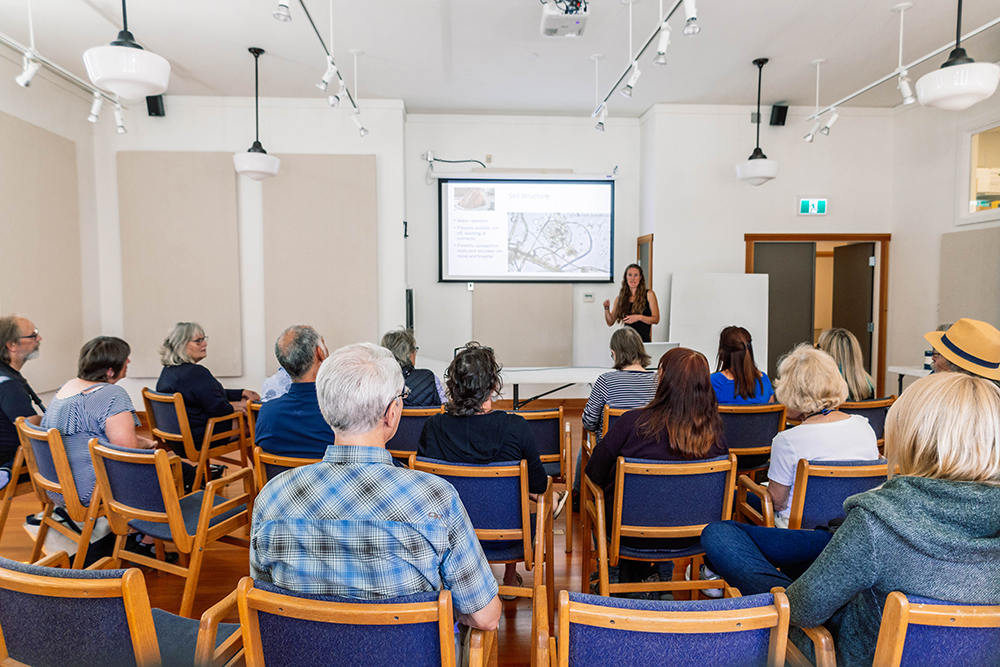
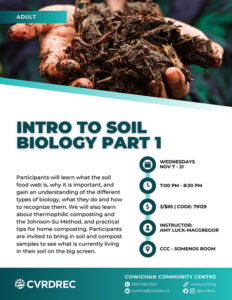 Participants will learn what the soil food web is, why it is important, and gain an understanding of the different types of biology, what they do and how to recognize them.
Participants will learn what the soil food web is, why it is important, and gain an understanding of the different types of biology, what they do and how to recognize them.
We will also learn about thermophillic composting and the Johnson-Su method, and practical tips for home composting. Participants are invited to bring in soil and compost samples to see what is currently living in their soil on the big screen.
Wednesdays 7:00pm‐8:30pm
Nov. 7‐21 | 3/$85 I Code: 79129
Instructor: Amy Luck‐MacGregor
Cowichan Community Centre
To register please call Cowichan Community Centre at 250.748.7529
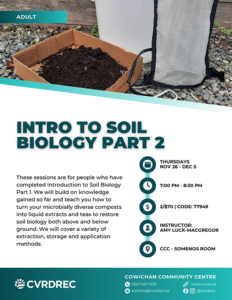 These sessions are for people who have completed Introduction to Soil Biology Part 1.
These sessions are for people who have completed Introduction to Soil Biology Part 1.
We will build on knowledge gained so far and teach you how to turn your microbially diverse composts into liquid extracts and teas to restore soil biology both above and below ground. We will cover a variety of extraction, storage and application methods.
Thursdays 7:00pm‐8:30pm
Nov. 28 – Dec. 5 | 2/$56 I Code: 79130
Instructor: Amy Luck‐MacGregor
Cowichan Community Centre
To register please call Cowichan Community Centre at 250.748.7529
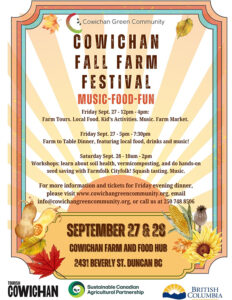 Join me for a family-friendly, drop-in style microbe workshop at the Cowichan Fall Farm Fest!
Join me for a family-friendly, drop-in style microbe workshop at the Cowichan Fall Farm Fest!
I’m thrilled to be partnering with Pacific Composting for this one. Kids (and their adults!) can learn all about composting with worms, and we’ll be checking out worm castings under the microscope to see “who” is home. Then learn how we turn those castings into an extract that can be used to restore and enhance living soil.
Thanks to an incredible collaboration with the ever-so-talented @protozoaprincess, we’ll have some pretty awesome microbe colouring sheets on hand too.
We’ll be at @cowichanfarmandfood from 10-2. Swing by, kids LOVE seeing the microbes that hang out beneath their feet!
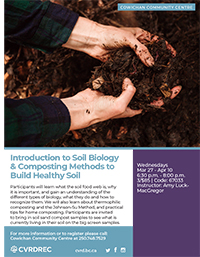
Participants will learn what the soil food web is, why it is important, and gain an understanding of the different types of biology, what they do and how to recognize them. We will also learn about thermophilic composting and the Johnson-Su Method, and practical tips for home composting. Participants are invited to bring in soil sand compost samples to see what is currently living in their soil on the big screen samples.
Wednesdays, Mar. 27 – Apr. 10 6:30 p.m. – 8:00 p.m.
3/$85 | Code: 67033
To register please call Cowichan Community Centre at 250.748.7529
Free presentation
Learn with the soil food web is, why it is important and gain an understanding of the different types of biology, what they do and how to recognize them.
REGISTRATION IS CLOSED
Curious about soil biology? In this introductory workshop you will come away inspired to look more closely at the life beneath your feet and to appreciate all that the soil microbial community contributes to the health of plants, animals, us, and to the planet as a whole.
REGISTRATION IS CLOSED
 Key to any soil regeneration effort is knowing where your soil is currently at. Are all of the beneficial groups of organisms home in your soil? Are there organisms present that could hinder plant growth? Is there a good level of diversity? Are the numbers adequate for the plant you want to grow?
Key to any soil regeneration effort is knowing where your soil is currently at. Are all of the beneficial groups of organisms home in your soil? Are there organisms present that could hinder plant growth? Is there a good level of diversity? Are the numbers adequate for the plant you want to grow? 
 Maybe you’ve made your own, or maybe you’re considering purchasing from a supplier.
Maybe you’ve made your own, or maybe you’re considering purchasing from a supplier. Compost extracts and teas are becoming increasingly popular. Recipes, advice and commercially made options abound on the internet. When made correctly from a biologically appropriate compost, extracts (where compost organisms are extracted into water and applied to soil immediately) and teas (where organisms are extracted into water, fed foods, and aerated for a period of time before being applied as a foliar spray) can be incredibly beneficial to the soil food web both above and below ground. It’s all about the process. When made incorrectly – for example adding the wrong type or amount of foods, brewing or resting for too long, using the wrong temperature or an inappropriate brewer or sprayer – you could find, at best, that you have gone to a lot of effort for nothing. At worst you could be doing more harm than good. What could end up being sprayed on that crop of spinach might enhance its growth and help protect it from pests and diseases, or it might result in diseased humans.
Compost extracts and teas are becoming increasingly popular. Recipes, advice and commercially made options abound on the internet. When made correctly from a biologically appropriate compost, extracts (where compost organisms are extracted into water and applied to soil immediately) and teas (where organisms are extracted into water, fed foods, and aerated for a period of time before being applied as a foliar spray) can be incredibly beneficial to the soil food web both above and below ground. It’s all about the process. When made incorrectly – for example adding the wrong type or amount of foods, brewing or resting for too long, using the wrong temperature or an inappropriate brewer or sprayer – you could find, at best, that you have gone to a lot of effort for nothing. At worst you could be doing more harm than good. What could end up being sprayed on that crop of spinach might enhance its growth and help protect it from pests and diseases, or it might result in diseased humans.